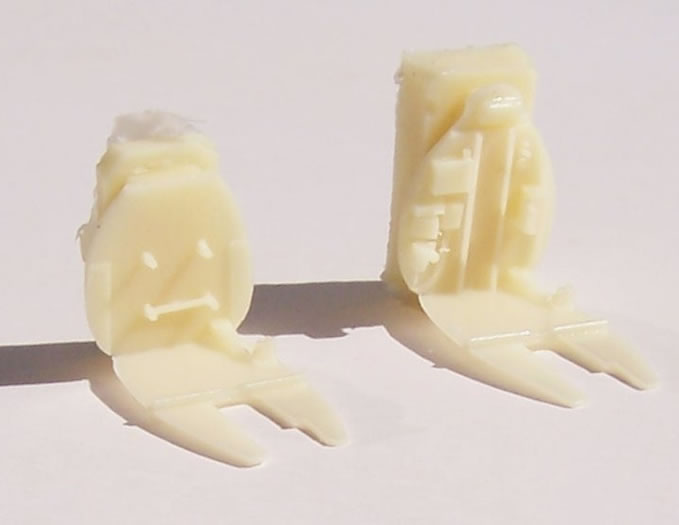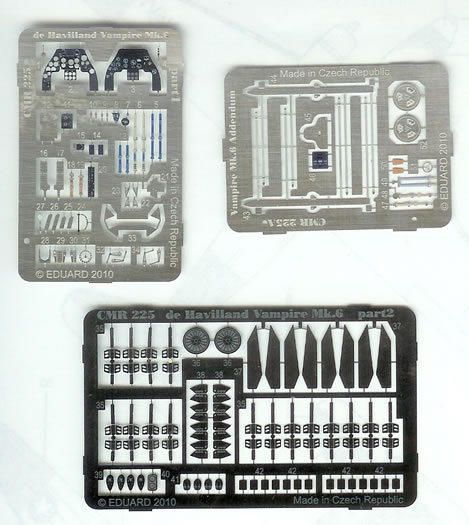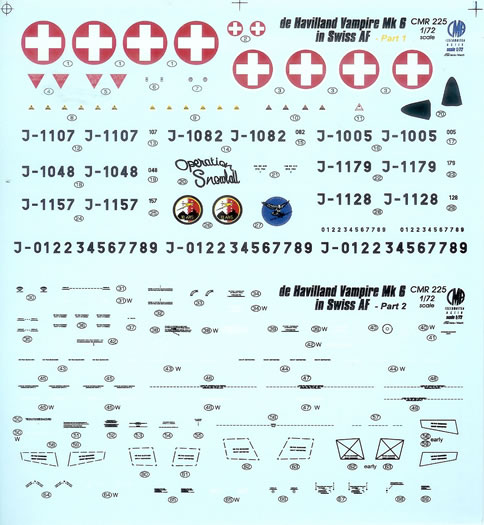de Havilland Vampire Mk.6 in Swiss AF

Czech Master Resin, 1/72 scale
S u m m a r y : |
Catalogue Number: |
225 |
Scale: |
1/72 |
Contents & Media: |
89 x cream resin airframe & stores parts, 7 x black resin undercarriage parts, 2 x Eduard coloured photo-etch (PE) frets (42 & 12 detail pieces each), 1 x plain PE fret (65 mainly weapons pieces), 4 x vac-form acetate canopies, 3 x Eduard pre-cut paint masks and decals for 7 aircraft |
Price: |
Available online from Hannants for £30.30, and various other CMR stockists. (Click here for currency conversion) |
Review Type: |
First Look |
Advantages: |
Highly detailed and very comprehensive kit. |
Disadvantages: |
None apparent. |
Conclusions: |
Suited to modellers with some resin and multi-media experience. A superb kit. |
Reviewed
by Mark Davies

HyperScale is proudly supported by Squadron.com
Flying only six months after Gloster’s Meteor in September 1943, the Vampire was Britain’s second production jet fighter. It would go on to be developed into a very successful family of fighter-bombers, two-seat all-weather fighters and trainers, as well as navalised versions, Widely exported, the Vampire was still in service with several airforces in the 1960’s and ‘70’s, and with the Swiss until 1990.
The Swiss Air Force was one of the earliest Vampire operators, and indeed also probably the last. Following an initial Vampire F.Mk 1 order in 1946, an order for F.Mk.6’s was placed in 1947, with the first aircraft arriving in 1949. The F.Mk 6 was based on the RAF’s FB.5, and was initially used in the interception role. Following the introduction of the Dh 112 Venom in the interceptor role, the F.Mk 6’s were increasingly employed in the ground support role, replacing the Swiss Air Force’s P-51 Mustangs and Morane D3801.

The Swiss improved their Mk.6 Vampires with the addition of ejector seats in 1960, which necessitated a slight change in canopy shape. Between 1979 and ’83 the Vampires acquired their pointed “Pinocchio” noses to accommodate an IFF transponder.
Previous 1/72 Vampires
The 1/72 injected Vampire kits I’m aware of include the old Frog kit and far superior Heller/Airfix issue, both FB.5’s (although Heller also offered a French Mistral). Revell has also boxed the Heller kit, and Marivox offered it with conversion parts to make and F.Mk 1. Recently released are an F Mk 1 & FB.6 by A-Model. These appear nicely executed, but have some troubling accuracy and shape. CMR has previously offered the Vampire prototype (called the Spidercrab) and some two-seat versions. Since 2009 they have been releasing a wide range all-new single-seat Vampire kits in “Hi-Tech” multi-media format covering many marks and versions. The F.MK 6 Swiss AF boxing reviewed below is the latest.
The kit comes packaged in CMR’s now standard sturdy top opening box. The parts and decals are in heat sealed plastic bags, which in turn are sealed in a further bag with the instructions and photo-walkaround.
The very detailed instructions consist of double-sided A4 pages (see here). The parts map and constructional illustrations are very clear and easy to follow. However, there is a lot to pay attention to, and CMR have gone to considerable lengths to provide detailed guidance where needed. This is one of those kits where the builder really should become familiar with the instructions before commencing work. Indeed, scanning the instructions, I came to appreciate just how much research work and attention to detail has gone into this kit, and the subtle differences associated with the Swiss AF versions. It’s a great deal more than providing two fuselage choices to cater for the IFF nose. Fortunately the many choices are cross-referenced to the various colour schemes. So my advice is definitely decide which one you’re going to build at the beginning!
Double-sided pages give comprehensive painting and markings plans. Colour notes and other written instructions are in English, with FS 595A and/or RAL paint reference numbers provided as well. More double-sided pages provide an excellent photo supplement focused on various aspects of the Swiss F.Mk 6’s. A brief history of Swiss AF Vampires is given English and French.
The kit’s resin parts are in CMR’s usual cream resin, and very nicely moulded with virtually no pinholes. A little flash is evident in a couple of places, but this can be removed easily and in seconds. The undercarriage is in a black resin that provides greater strength than the cream resin for fine weight-bearing parts.
The kit is awash with detail. Considerable attention to detail has been paid to the cockpit, wheel wells and flap bays. Detail levels are further enhanced by the pre-coloured Eduard PE set provided.

A choice of fixed or ejection seats is given, along with their associated style of canopy and cockpit rear bulkhead. Two copies of the canopy provide for insurance or practice when cutting out. They come with an Eduard pre-cut mask which simply serves to make life easy when it comes to painting. CMR have provided the seat belts on the pre-coloured PE fret. At first I was a little sceptical of this approach, as I quite like my belts cast with the resin seat in this scale. However, having recently completed seats for my CMR Jet Provost using the same system, I can advise that the finished result is very nice.

What is particularly interesting is the range of underwing ordinance, much of it unique to the Swiss, associated with the aircraft’s later ground support role. A range of bombs, tanks and rockets are sure to add interest, especially once their very delicate PE fins are attached.
There are seven markings options, and special mention must be made of one and the payload associated with it. This is the “Operation Snowball” aircraft that has this title emblazoned on the rear fuselage along with the pilot’s skis attached to the aircraft’s tail-booms! These skis are provided on the PE fret along with the straps to hold them on. A small photograph of this aircraft is provided separately from the photo supplement pages. The distinctive red and black striped option comes complete with pre-cut mask to make life easy when painting. And for those that like anniversaries there is the Vampire farewell scheme as an option too.

Decals are typical of CMR, being well registered and suggest good opacity. Based on past experience they should be very good to use; but like most Czech decals they will be quite thin and need to be floated into position, as they tend to adhere extremely well once there is no fluid under them. Markings for sven Swiss AF schemes are included.
This is a superbly executed kit reflecting some very thorough research and attention to detail. Despite some tiny parts and twin-boom layout it should go together in a straightforward manner – Just be familiar with those instructions!
Without doubt, this is the definitive Swiss Vampire F.MK6 kit, and it is highly recommended.
Thanks to Czech Master Resin for this review sample.
CMR Models are available
online from Hannants in the UK,
Red Roo Models in Australia
and
quality specialist model retailers worldwide.
Text Copyright © 2010 by Mark Davies
This Page Created on 13 September, 2010
Last updated
13 September, 2010
Back to HyperScale
Main Page
Back to Reviews
Page
 |
